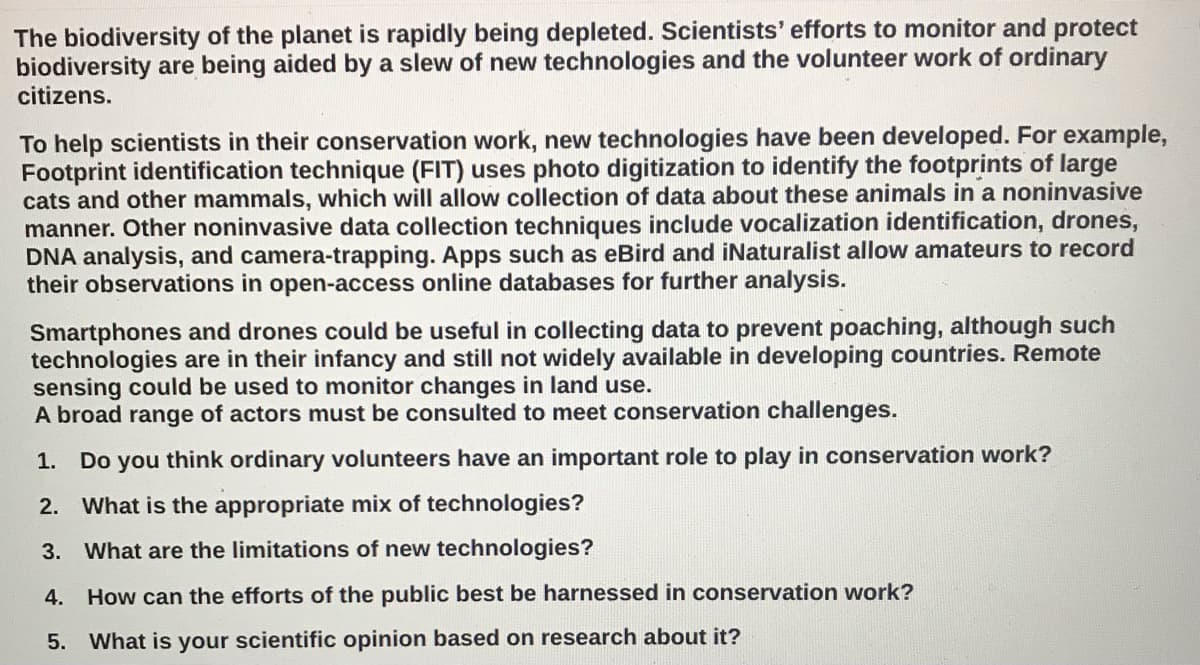1. Do you think ordinary volunteers have an important role to play in conservation work? 2. What is the appropriate mix of technologies? 3. What are the limitations of new technologies? 4. How can the efforts of the public best be harnessed in conservation work? 5. What is your scientific opinion based on research about it?
1. Do you think ordinary volunteers have an important role to play in conservation work? 2. What is the appropriate mix of technologies? 3. What are the limitations of new technologies? 4. How can the efforts of the public best be harnessed in conservation work? 5. What is your scientific opinion based on research about it?
Biology: The Dynamic Science (MindTap Course List)
4th Edition
ISBN:9781305389892
Author:Peter J. Russell, Paul E. Hertz, Beverly McMillan
Publisher:Peter J. Russell, Paul E. Hertz, Beverly McMillan
Chapter55: Biodiversity And Conservation Biology
Section: Chapter Questions
Problem 1ITD
Related questions
Question
100%

Transcribed Image Text:The biodiversity of the planet is rapidly being depleted. Scientists' efforts to monitor and protect
biodiversity are being aided by a slew of new technologies and the volunteer work of ordinary
citizens.
To help scientists in their conservation work, new technologies have been developed. For example,
Footprint identification technique (FIT) uses photo digitization to identify the footprints of large
cats and other mammals, which will allow collection of data about these animals in a noninvasive
manner. Other noninvasive data collection techniques include vocalization identification, drones,
DNA analysis, and camera-trapping. Apps such as eBird and iNaturalist allow amateurs to record
their observations in open-access online databases for further analysis.
Smartphones and drones could be useful in collecting data to prevent poaching, although such
technologies are in their infancy and still not widely available in developing countries. Remote
sensing could be used to monitor changes in land use.
A broad range of actors must be consulted to meet conservation challenges.
1. Do you think ordinary volunteers have an important role to play in conservation work?
2. What is the appropriate mix of technologies?
3.
What are the limitations of new technologies?
4. How can the efforts of the public best be harnessed in conservation work?
5. What is your scientific opinion based on research about it?
Expert Solution
This question has been solved!
Explore an expertly crafted, step-by-step solution for a thorough understanding of key concepts.
This is a popular solution!
Trending now
This is a popular solution!
Step by step
Solved in 2 steps

Knowledge Booster
Learn more about
Need a deep-dive on the concept behind this application? Look no further. Learn more about this topic, biology and related others by exploring similar questions and additional content below.Recommended textbooks for you

Biology: The Dynamic Science (MindTap Course List)
Biology
ISBN:
9781305389892
Author:
Peter J. Russell, Paul E. Hertz, Beverly McMillan
Publisher:
Cengage Learning


Biology: The Dynamic Science (MindTap Course List)
Biology
ISBN:
9781305389892
Author:
Peter J. Russell, Paul E. Hertz, Beverly McMillan
Publisher:
Cengage Learning
